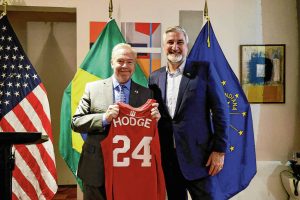Amid an international trip to Brazil and Mexico, Indiana Gov. Eric Holcomb says there’s progress for the state’s future economic development.
Speaking to reporters in a video call from Mexico City on Thursday, Holcomb discussed the state’s economic development amid his final months in office and how conversations with businesses, government officials and other organizations have gone during his first trip as Governor to Brazil and Mexico.
He also took time to address a recent shooting on the border, where an Indiana National Guard soldier reportedly shot at someone believed to have been stabbing a migrant.
Trip background
A majority of the call with reporters was focused on Holcomb’s week-long trip to Brazil and Mexico, his second international trip of 2024 and 22nd as governor. It was paid for by the Indiana Economic Development Foundation.
The goal of the trip is to “cultivate” innovation and growth of the agbioscience and agricultural economy, which continues to be a “catalyst” for economic and community growth for Indiana. The state’s agbioscience and agricultural fields contribute $58.1 billion to the state’s economy, Holcomb’s office said in a news release ahead of the trip.
Brazil and Mexico represent opportunities to collaborate and to “mutually advance trade, innovation and investment across the sector,” his office said. Indiana is home to 14 Brazil-based and 13 Mexico-based companies.
Holcomb was joined on the trip by a large delegation, including business leaders from Indiana companies and university experts, as well as representatives from corn and soybean interest groups, according to his office.
Progress made

With his trip nearly over, Holcomb hinted that progress has been made on projects the state had been working on before the trip.
“Details [are] yet to be shared but I’m growing in confidence that they will be realized. And we have some new prospects and some new possibilities,” Holcomb said.
Discussions with stakeholders haven’t changed despite his time in office coming to an end, he said. There will be work that has to be done by his successor — whoever that may be.
“Folks that I’m sitting across the table with — knowing that I have that 6,480 hours left — they want to make sure that the trajectory is moving in the right direction and it’s going to continue. … They are heartened that I’m still on the road, pitching Indiana ag,” he said.
Holcomb also touted “strong bonds” formed on the trip, including bonds regarding food and nutrition research and collaboration. The agricultural and agbiosciences sectors mean a lot to Hoosiers’ bottom lines each year, but this number “could be even bigger because of the work those companies are doing,” he said.
Indiana agriculture is needed in the world, and Hoosiers need Mexico and Brazil to feed and fuel the world, Holcomb said. Companies who have operations abroad — Weaver Popcorn, Far Best Foods and Maple Leaf Farms— have become stronger because of the collaboration between all the parties involved, he said.
“The quality and quantity of Indiana’s ag is as strong as it’s ever been and trending even stronger as we develop new markets all over the world,” Holcomb said.
Agriculture’s future
Technological advancements in agriculture have come up during the trip too, including in conversations with government officials in Mexico. Whether it be logistics, manufacturing or agriculture, there is a transition underway and today “we find ourselves scaling up because of technology,” Holcomb said.
For a state like Indiana, which has specialty crops and markets all over the world, how the state will fit into this future has been discussed, he said.
“We’ve talked a lot about human health, animal health and plant health — genetics included,” Holcomb said. “We want to be a state that can cater to various clients, whether it’d be far away, our own [state] for sure. But for a state that has both quality and quantity, we think we’re hard to beat.”
Holcomb was also asked about what could be done back in Indiana to encourage local officials to buy into what he’s been doing overseas, along with enticing agricultural businesses and agricultural start-ups to come to the state. While there is “a lot more to be done” to inform councils, associations, the legislature and his possible successor, it’s paramount for them to go out and meet their customers, he said.
He again highlighted his meetings with Weaver Popcorn, Far Best Foods and Maple Leaf Farms as an example.
“We’ve met with them and talked about what more could we do that would strengthen our case, to grow our position in the market and that’s what needs to happen,” Holcomb said. “… I’ve got 270 days left, 6,480 hours, and I pledge to do it to my last hour, selling Indiana.”
Border shooting
The reported border shooting took place Sunday in El Paso, Texas, along the U.S.-Mexico border. After the soldier shot at the individual, the individual fled back into Mexico. It remains unclear what kind of gun they were shot with or whether they were struck, and details remain vague amid investigations, according to news reports.
At a departure ceremony at Camp Atterbury last month for the soldiers, Holcomb said the role of the Indiana National Guard was assisting, not arresting or apprehending. Thursday night, he said the shooting showed “just how dangerous” the guard’s mission can be.
“It shows … that there are criminals attempting to illegally enter our country. The investigation is still ongoing but they’re willing to murder in doing so,” he said.
Holcomb told reporters the investigation is ongoing, but also emphasized his support for the soldier and mission to support Texas’ efforts to close off their portion of the border.
“I am beyond thankful to this individual who potentially saved two lives by defending them and themselves,” Holcomb said. “I’m reassured that the training that they got before they deployed and assumed this active duty on the southern border was beneficial.”





